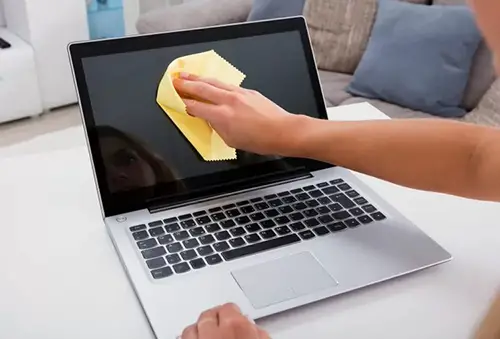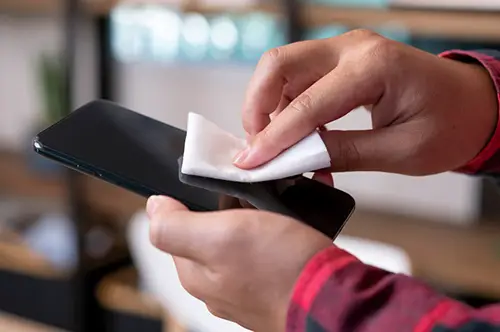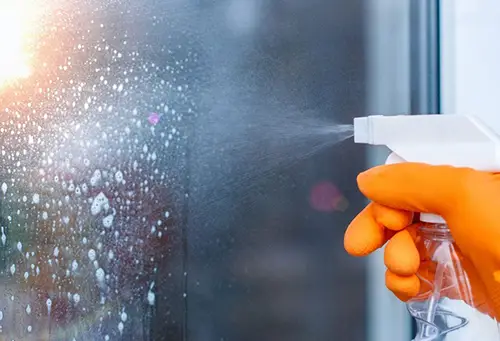Did you see our favorites?

Tempered glass is more long-lasting and durable than ordinary glass. If you don’t use the correct cleaning procedures, though, it may be scratched. Worry not; we’ll show you how to clean tempered glass in the following sections.
Glass, for some reason, is a material that many people take for granted. However, those streaks and hard water spots on your windows, mirrors, and vehicle windshields can be annoying. Learn how to clean glass using the best methods for a streak-free finish.
Because tempered glass has a texture and finish similar to that of your phone’s screen, these suggestions may also apply to your bare phone screen if you’re not using a screen protector. Read on to learn everything there is to know about how to clean tempered glass.


To begin, we’ve created a list of what not to do. Using these methods can result in irreparable damage to your phone’s screen or worse, your phone’s glass. Avoid using commercial cleaners or chemicals with strong alkaline compounds like Windex or alcohol. These solutions might remove the oleophobic layer from your protector, making it less pleasant to use.
Use mild soaps and pure water. High-quality liquid soap or dishwashing detergent should be used instead of powder soap. Use only soft, non abrasive cleaning materials. Dial it back—way back! These substances have the potential to scratch your protector and are not how to clean tempered glass in the right manner.

Tempered glass is the most popular material used in phone screen protectors today. They become filthy over time and need to be cleaned. Use the same materials as before, but add a blunt instrument such as a nail file to clean them.
Before you clean it, you’ll need to take off the screen protector. Cleaning solutions may seep through the edges and harm the phone as a result of overfilling. Additionally, you will not be able to clean the entire screen cover.
Remove the screen protector by nicking a corner with a nail file and putting it through. If you’re careful, don’t scratch the main screen underneath. Twist gently as you push the nail file into position around the phone’s screen to release the screen protector. The motion will aid in removing the screen protector.
Start by washing the protector in warm soapy water. Gently rub both sides of the glass with your fingers. Dirt and debris will be removed, as well as any smudges from oily substances, this way. To complete this phase of the procedure, use running water instead of tap water.
After cleaning the glass, use the microfiber cloth to dry it. Check the protector and make sure it’s clean. If any stains remain, baby wipes might be used to remove them. Baby wipes are made of non-abrasive materials and products, so they won’t damage the guard.
Once you’re certain the film is clean, dry it off. A microfiber cloth may be used for this process. Rub it firmly on both sides of the glass. If you want better results, consider using a lint roller.

If the phone’s screen is also dusty, use the microfiber cloth to wipe it. On this screen, do not use baby wipes. Spacing may separate the screen from the phone’s internal circuit. Baby wipes are nonalcoholic, so any wetness may seep into the internal components and create a short circuit.
The phone’s screen and cover should be dried in a cool, dry place. A plastic food container is ideal for this. Place the phone as well as the screen protector inside a paper towel-lined plastic food container. The items should be kept separate at all times. Never dry any of these items under direct sunlight or with hot air pending
You can only remove and replace the screen protector after it has completely dried. To avoid smudges on the screen protector when you replace it on the phone, make sure your hands are clean and dry.
Align the screen protector to the phone’s screen edges. Take care and move slowly when performing this operation. When you’ve positioned the screen protector over the phone’s corners, softly press each one. Using your thumb and forefinger, perform this technique. Begin at the closest corner and work your way toward the farthest.
It’s that simple! Simply remove the charger from its compartment, then remove the plastic film from around it. Once you’ve done that, carefully peel off the protective layer of glue. You’re now halfway there! Remove any air bubbles between the screen protector and the phone’s display using this method. Air bubbles cause dust to enter and accumulate on the screen. In addition, they hinder the screen protector from properly adhering to the display surface. That’s all there is to it!

The first thing to check is that all of your supplies are clean. For instance, make sure the spray bottle is completely washed before using it. If possible, use warm water instead of hot.
If you don’t have a clean microfibre cloth, use a paper towel instead. The best choice is a lint-free paper towel. Follow these procedures to polish your tempered glass products once you’ve got the right equipment on hand.
The way you make your cleaning solution has an impact on the entire cleaning process. You want to strike a good balance between water and dishwashing detergent. Try using a 1:1 ratio of water and dishwashing soap. thoroughly combine this solution before transferring it to the spray bottle
Spray the table surface with the spray bottle, keeping it approximately 7 to 8 inches away. Spray equally across the whole surface, ensuring you can’t see through it when finished. Allow the solution to sit for at least half a minute. This is the ideal duration since it allows the solution to absorb all of the dirt. If you leave it sitting for longer, it will begin to dry and become more difficult to complete the procedure.
Use a clean and damp sponge to remove the solution since you won’t be able to use a hose. The reason why you need a non-abrasive sponge is to avoid harming the glass. Remove all of the cleaning solution that you used previously with gentle rubbing motions.
The sponge may be immersed in the solution in other situations, making rinsing the glass difficult. If this occurs, rinse the sponge with running water and squeeze it to dry. Repeat the washing process until all of the cleaning solution is removed. When you can almost see through the glass after cleaning, you’ll know you did a fantastic job.
Dry the glass using a microfibre cloth or lint-free paper towel. The most effective drying technique is to move in a circular motion while avoiding scratches to your glass. When cleaning and drying the glass, avoid squeegees of any kind. They may scratch the surface by dragging tiny dirt across it.
This means that not all tempered glass is the same. Some tempered glass, for example, has a coating, but tabletops and doors do not. If your tempered glass doesn’t have a covering, you can use certain glass cleaners with caution. However, keep in mind that these items should not be used on your tempered glass.
Tempered glass is superior for your phone’s screen or shower door since it is more durable than regular glass. Cleaning, on the other hand, requires a light touch. Clean your tempered glass using a soft damp cloth and mild soap to restore it to its original condition.

In a spray bottle, prepare a cleaning solution of equal parts dish soap and water. To make a cleaning solution, combine an equal amount of mild, non-abrasive dish soap and clean water in a bowl. Stir the mixture gently to combine the solution and then pour it into a clean spray bottle with the cap screwed on. Shake the container lightly to distribute the detergent throughout it. Spray a mild cleaning solution on the glass instead of spraying glass cleaner and it is less likely to scratch your tempered glass. Spray the cleaning solution onto the screen and let it sit for 10 to 15 seconds. Make sure you cover all of the surfaces that need to be cleaned. The water will soak into the dirt while sitting, making washing easier.

It’s fine if the solution continues to run since you’ll be wiping it away. However, place a towel at the bottom of the window pane to prevent the solution from leaking down into it. Using clean water, soak a soft sponge in one hand and gently rub it over the glass with the other. Start at the top of your window, panel, or shower door and work your way down. To completely remove the cleaning solution, rinse out and then soak the sponge in clean water several times as you clean your glass.
Get a professional coating to ensure long-lasting protection. If you’d want to clean up faster or have less frequent cleaning, contact a local window or glass business. After that, you may engage the services of a professional cleaner to apply a protective glass finish. They can protect the surface of the glass and make it simpler to remove dirt and grime from it.
If you apply a protective coating to exterior tempered glass like on a windshield, rainwater will run off of the glass instead of sit on it.
Did you see our favorites?
CleaningProductsLab.com is a participant in the Amazon.com Services LLC Associates Program. As an Amazon Associate we earn from qualifying purchases.
Amazon and the Amazon logo are trademarks of Amazon.com, Inc. or its affiliates.
The information on this blog is not meant as a substitute for medical advice, and should not be taken as such.